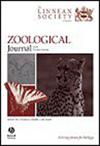Ancient mitogenomes reveal evidence for the Late Miocene dispersal of mergansers to the Southern Hemisphere
IF 3
2区 生物学
Q1 ZOOLOGY
引用次数: 0
Abstract
Mergansers are riverine and coastal piscivorous ducks that are widespread throughout North America and Eurasia but uncommon in the Southern Hemisphere. One species occurs in South America and at least two extinct species are known from New Zealand. It has been proposed that these Southern Hemisphere merganser lineages were founded by at least two independent dispersal events from the Northern Hemisphere. However, some morphological and behavioural evidence suggests that Southern Hemisphere mergansers may form a monophyletic clade that descended from only a single dispersal event from the Northern Hemisphere. For example, Southern Hemisphere mergansers share several characteristics that differ from Northern Hemisphere mergansers (e.g. non-migratory vs. migratory, sexual monochromatism vs. sexual dichromatism, long vs. short pair bonds). We sequenced complete mitogenomes from the Brazilian merganser and an extinct merganser from New Zealand—the Auckland Island merganser. Our results show that the Brazilian and Auckland Island mergansers are not sister-taxa, and probably descend from two separate colonization events from the Northern Hemisphere at least 7 Mya. Nuclear (palaeo)genomic data may help to further resolve the relationship between living and extinct mergansers, including merganser fossils from New Zealand that have not been subjected to palaeogenetic analysis.古老的有丝分裂基因组揭示了晚中新世梅花鹿向南半球扩散的证据
梅花鸭是一种河流和沿海食鱼鸭,广泛分布于北美和欧亚大陆,但在南半球并不常见。南美洲有一个物种,新西兰至少有两个已灭绝的物种。有人认为,这些南半球的梅花鹿品系是由至少两次独立的北半球扩散事件形成的。然而,一些形态学和行为学证据表明,南半球梅花鹿可能形成一个单系支系,仅是北半球一次扩散事件的后裔。例如,南半球梅花鹿具有与北半球梅花鹿不同的一些特征(如非迁徙性与迁徙性、性单色性与性双色性、长配对结合与短配对结合)。我们对巴西梅花鹿和新西兰已灭绝的梅花鹿--奥克兰岛梅花鹿的有丝分裂基因组进行了完整测序。我们的研究结果表明,巴西梅花鹿和奥克兰岛梅花鹿并不是姊妹种,它们可能是在至少 7 Mya 年前从北半球两次不同的殖民事件中分离出来的。核(古)基因组数据可能有助于进一步解决现生和已灭绝梅花鹿之间的关系,包括尚未进行古遗传分析的新西兰梅花鹿化石。
本文章由计算机程序翻译,如有差异,请以英文原文为准。
求助全文
约1分钟内获得全文
求助全文
来源期刊
CiteScore
6.50
自引率
10.70%
发文量
116
审稿时长
6-12 weeks
期刊介绍:
The Zoological Journal of the Linnean Society publishes papers on systematic and evolutionary zoology and comparative, functional and other studies where relevant to these areas. Studies of extinct as well as living animals are included. Reviews are also published; these may be invited by the Editorial Board, but uninvited reviews may also be considered. The Zoological Journal also has a wide circulation amongst zoologists and although narrowly specialized papers are not excluded, potential authors should bear that readership in mind.

 求助内容:
求助内容: 应助结果提醒方式:
应助结果提醒方式:


